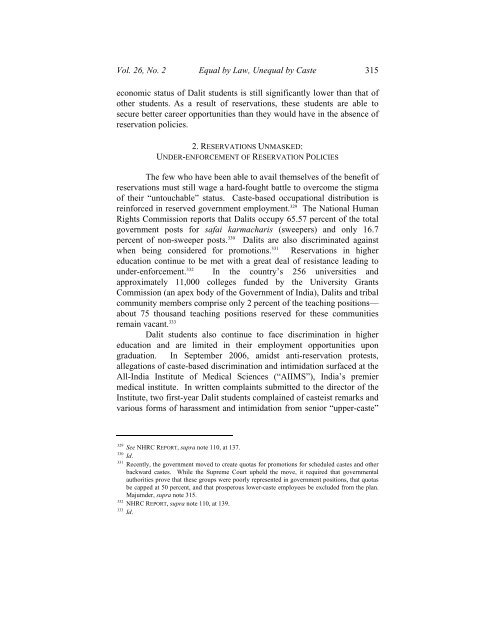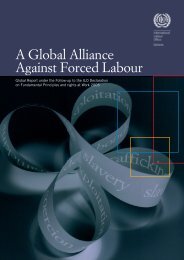314 Wisconsin <strong>International</strong> Law Journalaction <strong>Dalit</strong>s would not be able to penetrate the <strong>caste</strong> ceiling in educationand employment that results from entrenched anti-<strong>Dalit</strong> biases. 324 Theyadd that there are no objective standards of merit applicable to all groupswithin society, given that dominant groups shape traditions within whichthey make judgments of merit. 325 Further, they support reservations onthe basis of national diversity, arguing that different views should berepresented in national institutions to promote diversity, which ultimatelybenefits the social and the political life of the country. 326Supporters also point to evidence that reservation policies havebeen successful in some areas. Reservations in local government bodies,such as village councils or panchayats, for example, have enhanced thedelivery of local public goods to disadvantaged groups. 327 Similarly,reservations in higher education have afforded greater opportunities to<strong>Dalit</strong> students. 328 While the reservation policies tend to benefit the socalled“creamy layer” of the <strong>Dalit</strong> population, the average sociohttp://62.237.131.23/conference/conference-2003-2/conference-2003-2-programme.htm(lastvisited Aug. 16, 2008). Alexander notes the evident but limited steps toward <strong>equal</strong>ity forscheduled <strong>caste</strong>s and tribes due to reservations in political representation, public employmentand education, and argues that the effectiveness of affirmative action is undermined <strong>by</strong>inattention to variations among different sub-<strong>caste</strong>s of “untouchables” and because of severedisparities in lower <strong>caste</strong>s’ relative disadvantage across states and between urban and rural areas.As a result, reservations and similar measures have for the most part benefited only the relativelybetter off among lower <strong>caste</strong>s. Id.324 See D. Parthasararthy, Reservations: Towards a Larger Perspective, in RESERVATION INPRIVATE SECTOR, supra note 158, at 193-96.325 Surinder S. Jodhka & Katherine Newman, In the Name of Globalisation: Meritocracy,Productivity and the Hidden Language of Caste, in LABOR MARKET DISCRIMINATION ANDURBAN SECTOR 19 (Indian Institute of <strong>Dalit</strong> Studies & Princeton University eds., 2007) (on filewith author) [hereinafter LABOR MARKET DISCRIMINATION]. The authors use interviews withprivate sector hiring managers to unpack the apparently neutral concept of “merit,” revealing acommon recruiter tendency to rely on family background, which is at least implicitly a proxy for<strong>caste</strong>, as an assurance of an individual’s reliability and character. The authors also show theprevalence of using regional stereotypes, often derogatory, as gauges of candidates’ competence.Id. at 27. See also Anand Teltumbde, Reservation in the Private Sector: An Overview of theProposition, in RESERVATION IN PRIVATE SECTOR, supra note 158, at 275-77, 279-80.326 Sridharan, supra note 179, at 117.327 In Impact of Reservation in Panchayati Raj: Evidence from a Nationwide RandomizedExperiment, Chattopadhyay and Duflo summarize the findings of their research in districts inWest Bengal and Rajasthan. According to the authors, “[l]ocal leaders seem to have someeffective control over decisions, even when they are women or SCs [Scheduled Castes].”Raghabendra Chattopadhyay & Esther Duflo, Impact of Reservation in Panchayati Raj:Evidence from a Nationwide Randomised Experiment, ECON. & POL. WKLY., Jan.-Apr. 2004, at979.328 Thomas E. Weisskopf, Impact of Reservation in Admissions to Higher Education in India, ECON.& POL. WKLY, July-Sept. 2004, at 4339. See also CHALAM, supra note 171, at 107, 142, 162(arguing further that educational reservations in south Indian states have contributed to their highscores on the Human Development Index, despite their lower economic status).
Vol. 26, No. 2 Equal <strong>by</strong> Law, Un<strong>equal</strong> <strong>by</strong> Caste 315economic status of <strong>Dalit</strong> students is still significantly lower than that ofother students. As a result of reservations, these students are able tosecure better career opportunities than they would have in the absence ofreservation policies.2. RESERVATIONS UNMASKED:UNDER-ENFORCEMENT OF RESERVATION POLICIESThe few who have been able to avail themselves of the benefit ofreservations must still wage a hard-fought battle to overcome the stigmaof their “untouchable” status. Caste-based occupational distribution isreinforced in reserved government employment. 329 The National HumanRights Commission reports that <strong>Dalit</strong>s occupy 65.57 percent of the totalgovernment posts for safai karmacharis (sweepers) and only 16.7percent of non-sweeper posts. 330 <strong>Dalit</strong>s are also discriminated againstwhen being considered for promotions. 331 Reservations in highereducation continue to be met with a great deal of resistance leading tounder-enforcement. 332 In the country’s 256 universities andapproximately 11,000 colleges funded <strong>by</strong> the University GrantsCommission (an apex body of the Government of India), <strong>Dalit</strong>s and tribalcommunity members comprise only 2 percent of the teaching positions—about 75 thousand teaching positions reserved for these communitiesremain vacant. 333<strong>Dalit</strong> students also continue to face discrimination in highereducation and are limited in their employment opportunities upongraduation. In September 2006, amidst anti-reservation protests,allegations of <strong>caste</strong>-based discrimination and intimidation surfaced at theAll-India Institute of Medical Sciences (“AIIMS”), India’s premiermedical institute. In written complaints submitted to the director of theInstitute, two first-year <strong>Dalit</strong> students complained of <strong>caste</strong>ist remarks andvarious forms of harassment and intimidation from senior “upper-<strong>caste</strong>”329 See NHRC REPORT, supra note 110, at 137.330 Id.331 Recently, the government moved to create quotas for promotions for scheduled <strong>caste</strong>s and otherbackward <strong>caste</strong>s. While the Supreme Court upheld the move, it required that governmentalauthorities prove that these groups were poorly represented in government positions, that quotasbe capped at 50 percent, and that prosperous lower-<strong>caste</strong> employees be excluded from the plan.Majumder, supra note 315.332 NHRC REPORT, supra note 110, at 139.333 Id.
- Page 1 and 2:
EQUAL BY LAW, UNEQUAL BY CASTE: THE
- Page 3 and 4:
Vol. 26, No. 2 Equal by Law, Unequa
- Page 5 and 6:
Vol. 26, No. 2 Equal by Law, Unequa
- Page 7 and 8:
Vol. 26, No. 2 Equal by Law, Unequa
- Page 9 and 10: Vol. 26, No. 2 Equal by Law, Unequa
- Page 11 and 12: Vol. 26, No. 2 Equal by Law, Unequa
- Page 13 and 14: Vol. 26, No. 2 Equal by Law, Unequa
- Page 15 and 16: Vol. 26, No. 2 Equal by Law, Unequa
- Page 17 and 18: Vol. 26, No. 2 Equal by Law, Unequa
- Page 19 and 20: Vol. 26, No. 2 Equal by Law, Unequa
- Page 21 and 22: Vol. 26, No. 2 Equal by Law, Unequa
- Page 23 and 24: Vol. 26, No. 2 Equal by Law, Unequa
- Page 25 and 26: Vol. 26, No. 2 Equal by Law, Unequa
- Page 27 and 28: Vol. 26, No. 2 Equal by Law, Unequa
- Page 29 and 30: Vol. 26, No. 2 Equal by Law, Unequa
- Page 31 and 32: Vol. 26, No. 2 Equal by Law, Unequa
- Page 33 and 34: Vol. 26, No. 2 Equal by Law, Unequa
- Page 35 and 36: Vol. 26, No. 2 Equal by Law, Unequa
- Page 37 and 38: Vol. 26, No. 2 Equal by Law, Unequa
- Page 39 and 40: Vol. 26, No. 2 Equal by Law, Unequa
- Page 41 and 42: Vol. 26, No. 2 Equal by Law, Unequa
- Page 43 and 44: Vol. 26, No. 2 Equal by Law, Unequa
- Page 45 and 46: Vol. 26, No. 2 Equal by Law, Unequa
- Page 47 and 48: Vol. 26, No. 2 Equal by Law, Unequa
- Page 49 and 50: Vol. 26, No. 2 Equal by Law, Unequa
- Page 51 and 52: Vol. 26, No. 2 Equal by Law, Unequa
- Page 53 and 54: Vol. 26, No. 2 Equal by Law, Unequa
- Page 55: Vol. 26, No. 2 Equal by Law, Unequa
- Page 58 and 59: 312 Wisconsin International Law Jou
- Page 62 and 63: 316 Wisconsin International Law Jou
- Page 64 and 65: 318 Wisconsin International Law Jou
- Page 66 and 67: 320 Wisconsin International Law Jou
- Page 68 and 69: 322 Wisconsin International Law Jou
- Page 70 and 71: 324 Wisconsin International Law Jou
- Page 72 and 73: 326 Wisconsin International Law Jou
- Page 74 and 75: 328 Wisconsin International Law Jou
- Page 76 and 77: 330 Wisconsin International Law Jou
- Page 78 and 79: 332 Wisconsin International Law Jou
- Page 80 and 81: 334 Wisconsin International Law Jou
- Page 82 and 83: 336 Wisconsin International Law Jou
- Page 84 and 85: 338 Wisconsin International Law Jou
- Page 86 and 87: 340 Wisconsin International Law Jou
- Page 88 and 89: 342 Wisconsin International Law Jou
















